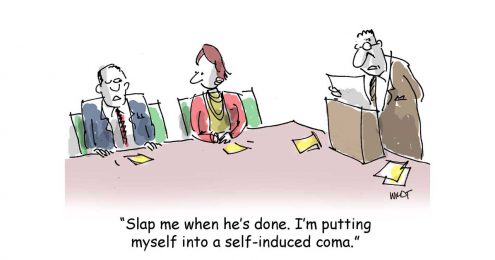This might be the most common question people get asked when meeting someone new:
“So what do you do?”
If you are on the board or staff of a nonprofit organization, this question is a gift. And you can’t screw it up.
What does screwing up look like? Here are a few examples.
- “I’m a CPA” (neglecting to mention that you are the treasurer of the board of an organization you care deeply about)
- “I run a small museum in XYZ town.”
- “I ‘just’ do admin work for our local JCC”
So, why are these examples of “screwing up?”
Well, because as a staff or board member, you are an organizational ambassador who needs to take every opportunity to share the good news about the impact of your organization, to share your own passion and commitment, and to invite folks to learn more (and maybe do more).
I believe that the question “What do you do?” is one big fat opportunity to do that ambassador thing. So here’s how to take the examples above and turn them into invitations.
- “By day I am a CPA but my real passion is in my volunteer work as a board member at XYZ. Can I tell you a little about it?”
- “I have the great good fortune to run our community museum, and it gives me the opportunity to share history and be sure that we understand and appreciate the people, art, etc. that have come before us. Can I tell you a little more about our work?”
- “So I am a part of an amazing team at the West Orange JCC — I feel lucky to be a part of an organization that offers so much to our community. Can I tell you a little about our work?”
I think board and some staff members find this approach hard. And I know why.
- They don’t recognize the power of nonprofit storytelling — that it is central to fundraising.
- They don’t see themselves as storytellers.
- They think the ED is the storyteller in chief.
- They aren’t good at talking to others about the organization.
Rest easy my friends. This is fixable. Totally. And today I’m going to help you.
More importantly, you have to fix it. You can’t raise money unless you do. You see I have this equation I’d like you to think about and infuse into your ambassador DNA:
Credible messenger + Compelling Story = $$$
By virtue of your affiliation with your organization, you are a credible messenger. Remember that. Own the privilege and responsibility that comes with it.
And then the second piece of the equation? You have to work on it, exercise the muscle and become a first-rate storyteller.
And today I’ll offer you 10 tips to get your nonprofit storytelling right.
TEN TIPS TO GET YOUR NONPROFIT STORYTELLING RIGHT
- Keep your story under 3 minutes
This one is hard which is why it’s #1 is on this list of tips. When you love the organization you are affiliated with, it’s easy to go on and on. Rambling is a huge problem for nonprofit leaders. We don’t want to leave anything out. You have to prioritize and then invite them to know more (see #9). - Put your mission statement away — use your own words
Most organizations wordsmith a mission statement for hours and take all the emotion out of it. Not to mention the fact that when a group of 15 people wordsmith a 2-3 sentence mission statement, the end product can actually be unintelligible. - Think about the story like a bicycle wheel
The people you serve are the center and the services are the “how.” If you think of it this way, you will avoid making a list of services (boring and forgettable). Here’s an example:“At GMHC we advocate for people living with HIV/AIDS (center). For our clients, it’s about so much more than living with an incurable disease. Did you know that folks living with HIV need an array of services from mental health to legal counsel to X to Y?”
Now instead of a list, I put the client in the center and offer an example of some of the different “hows.” I also have educated the listener about the impact HIV has on all aspects of our clients’ lives.
- Ask them: Can I tell you a quick story?
The anecdote must be brief and it must be current. Your story cannot be abstract. If privacy is an issue, then say so and tell the story with, “So we can’t share real names so let’s call this client Yolanda.”And not just the names of clients. You can also talk about Joe the driver who has delivered food for 10 years or CJ the volunteer who does X. We want someone to feel like they are really close to the work and that they are able to visualize all these wonderful things happening.
Most importantly, the story can be the centerpiece that includes some of the other items on this tip list.
- Share a data point using the phrase “Did you know?”
The use of this phrase enables you to help someone see the magnitude of the problem you are working to solve: “Did you know that an LGBTQ young person commits suicide every ____ minutes?” - Include an impact statement
Tell the listener something about the number of clients your org has served, the growth in that number, and the size of the population you could serve with additional resources. - Offer a sense of the size of your organization
This should be a very brief comment, almost a throwaway — we do all this on a budget of X with a staff of Y. - Work in something about leadership
People invest in the work for sure AND they like to know that you are confident in how the organization is being led and managed. - Invite them to learn more
Every single story should end with, “Would you like to know more?” Two reasons. First, people won’t ever hear a good story and say, “Nope, not really interested in knowing more.” And secondly, you have been given permission to continue to cultivate that relationship. It may not lead to $ — but it could lead you to your next volunteer or board member or a pro bono / in-kind gift. - Practice, practice, practice
Not at home in front of a mirror. Not once a year at a board retreat. Don’t gasp, but I think storytelling practice should be built into every board meeting and every staff meeting. It can be a team-building exercise, it can be built into the development committee report, and it should take no longer than 10 minutes.
I have many clients who are now doing this regularly, and it reminds their board and staff that they are leaders and ambassadors. And the regularity of it allows for the muscle to be built.
Here’s a one-page recipe for how to approach a 10-minute practice session.
–> DOWNLOAD THE STORYTELLING RECIPE HERE
Want to learn from a growing community of nonprofit leaders and get exclusive access to content from a variety of experts? Click here to learn more about the Nonprofit Leadership Lab.



